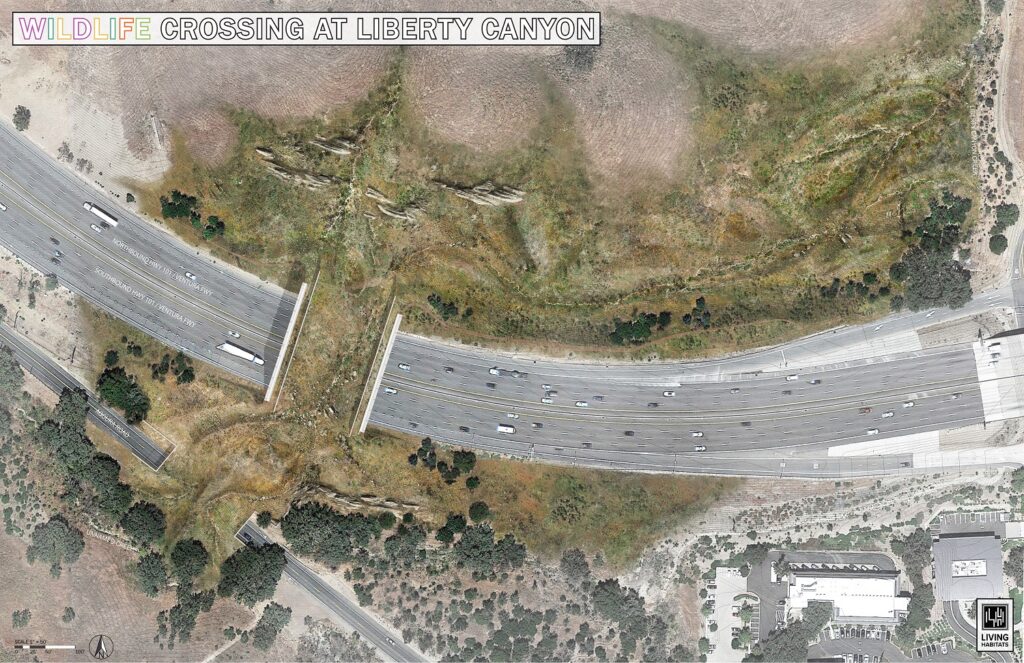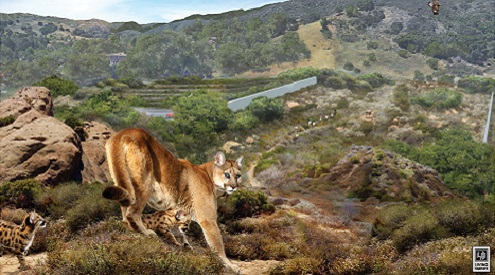The wildlife crossing at Liberty Canyon will be the largest of its kind, and is expected to serve as a global model for urban wildlife conservation. Now, new conceptual design illustrations released by the National Wildlife Federation reveal what the overpass will look like.

The NWF released a series of new images that show how the design of the wildlife crossing is advancing. The project has undergone a rigorous and lengthy planning process and is expected to break ground in 2021.
The project comes after two decades of National Park Service research that points to the urgent need to restore the connection between the Santa Monica Mountains with the Simi Hills severed by the construction of the freeway.
“In addition to saving the mountain lions from possible extinction, the crossing will also reconnect a long-fragmented ecosystem for all wildlife in an area recognized as one of only thirty-six biodiversity hotspots worldwide,” the press release states.
The wildlife crossing has been developed through a landmark public-private partnership that has brought together conservation organizations and government agencies to design an overpass that can help wildlife safely cross the 101 freeway at the only point in Los Angeles County where there is open space on both sides of the freeway. It’s a major engineering challenge: the crossing must extend over 10 lanes of traffic and a frontage road, provide a route that is safe for drivers below and wildlife above, and make it inviting so animals will find comfortable to use, while also ensuring that it blends into the landscaping.
The core partners include Caltrans, the National Park Service, the Santa Monica Mountains Conservancy, Resource Conservation District of the Santa Monica Mountains, and the National Wildlife Federation.
The project partners also recently added a design team led by the landscape architectural practice Living Habitats LLC to advance the project. Over the past year, the Living Habitats team has collaborated with Caltrans and coordinated with a broad team of experts in the planning and design development of the wildlife crossing.
The designs created by Living Habitats reveal a structure that integrates harmoniously into the surrounding hills, one with less visible concrete or ornamentation than earlier concepts.
Living Habitats has been working with Caltrans and the project partners on every aspect of the planning process. Unlike a traditional freeway overpass, the crossing will support wildlife and provide the habitat, shelter, food and water that individual species need to thrive. To achieve this, the top of the structure will be covered in nearly one acre of native vegetation.
With the help of Caltrans and the National Park Service, Living Habitats is collecting seeds, acorns and mushrooms that will be grown in a special project nursery. These will be planted on the site allowing the habitat to grow vegetation naturally throughout the site from the soil up. Native oak and willow trees sourced from the site will also be planted and nearly nine acres of space along the two adjoining slopes where the wildlife crossing will be built, will also be improved.
The crossing will be approximately 165 feet wide and because it will span 210 feet over ten lanes of pavement of the U.S. 101 freeway, it will rely on robust engineering and an innovative landscape design that will blend the structure into the surrounding mountain habitat. With as many as 300,000 cars passing through the freeway site daily, the crossing will also call for vegetated barriers to reduce the impact of vehicle traffic noise and roadway light on wildlife movement.
“This crossing will save the local mountain lion population from extinction, stand as a global model for urban wildlife conservation — and show us that it’s possible for a structure of this magnitude to be built in a such a densely populated urban area,” said Beth Pratt, California Executive Director for the National Wildlife Federation and leader of the #SaveLACougars campaign. “We owe it to the mountain lions and all wildlife to ensure their future in the Santa Monica Mountains.”
To learn more about the #SaveLACougars campaign to build the Wildlife Crossing at Liberty Canyon visit https://savelacougars.org/





